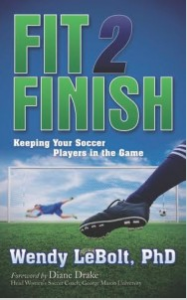Fit2Finish: More than “just playing the game” needed to keep our kids fit
Editor’s Note: The following excerpts are from Dr. Wendy LeBolt’s book Fit2Finish: Keeping Your Soccer Players in the Game. Learn about the book and find more resources here.
When I was growing up playing sports, nobody ever got hurt, at least not seriously. I don’t remember a single teammate ever complaining of knee pain, shin pain, heel pain or hip pain. Today nearly all young athletes eventually experience at least one of these maladies. What has changed since the “good ole days?”
Plenty. More kids are playing. There are more sports, more games, and more competitions all year round. Sometimes multiple sports overlap in the same season. We’re starting children younger and younger, on more competitive teams where more wins mean more in the rankings. Today is all about the “more.” We want to give our kids more of what used to be so good for us. And so we have. But it hasn’t always been so good for them.
Do you think young soccer players can become fit for the game just by playing the game?
The game is a great teacher, for sure, and the “just the game” approach has been taught by soccer educators for quite some time. But when it comes to fitness, the “just playing” is hobbling today’s players and may be predisposing them to injury. Demanding, competitive soccer environments create:
- Sidedness: Players tend to favor their strong side because under pressure they default to their strength. That makes weaknesses even weaker. Weakness and imbalance are risk factors.
- Patterns and Repetition: Players favor certain muscles and learned movement patterns (e.g. inner thigh for passing) This accentuates the acting muscles but takes attention away from the stabilizing and support muscles needed to provide balance to execute the skill. Joints are more likely to be injured without proper support on all sides.
- Habits: Players engage in habitual movement patterns that may be disadvantageous from an injury standpoint. (e.g. girls tend to execute stops, turns and landings straight-legged) This allows the quadriceps to overpower weaker hamstrings which puts knee ligaments at risk.
- Overtraining: Players subject muscles to repetitive use without proper recovery. (e.g. the running motion and knee extension in kicking activities pull repetitively on the patellar tendon often resulting in knee soreness and pain) This can be a source of imbalance and excessive fatigue, especially in growing athletes, and ultimately of injury.
All of these training errors can be addressed with modifications in training design which balance the demands on young bodies. High performance doesn’t need to be high risk, but it does require diligence, dedication and planning from the coach to keep preventable injury from creeping in.
‘Just let them play’ may be a great way to teach the game, but if we want them to keep playing and keep playing hard we need to design the building blocks for fitness and injury-prevention into the practice plan.
Fit2Finish: Keeping Your Soccer Player in the Game is your handbook to do just that.
3 Easy Ways to Increase Strength, Agility and Quickness – Fit2Finish
SOCCERWIRE MARKETPLACE
- Start the Season Strong at Loudoun Premier Cup!
- 50th Annual Rael Vodicka Memorial Tournament
- Soccer Marketing Internships at The St. James FC
- Job Opening: The St. James FC Goalkeeper Academy Coach
- Full-Time Director of Goalkeeping for The St. James FC
- visitRaleigh.com Showcase Series 2025, hosted by NCFC Youth
- OFFICIAL MANCHESTER CITY SOCCER CAMPS
- Join Official Elite Summer Soccer Camps with Europe’s Top Pro Clubs!
- OFFICIAL BAYERN MUNICH SUMMER CAMPS U.S.
- OFFICIAL FC BARCELONA CAMPS U.S.












